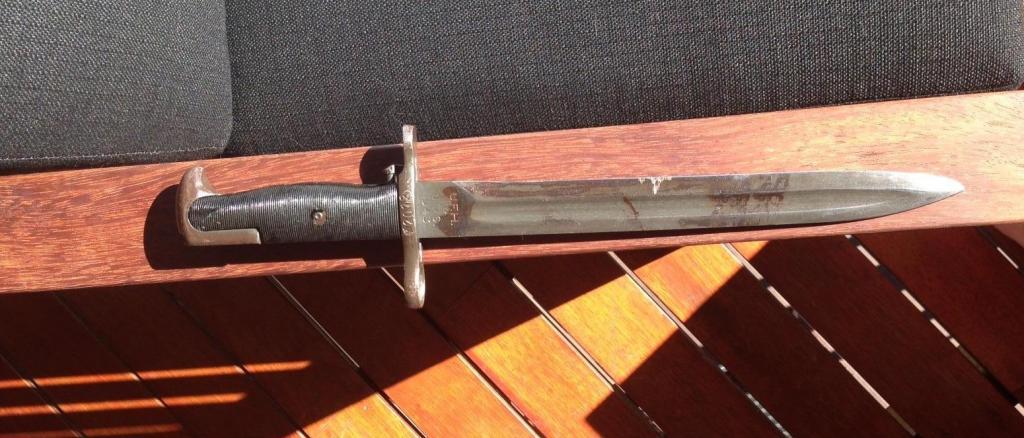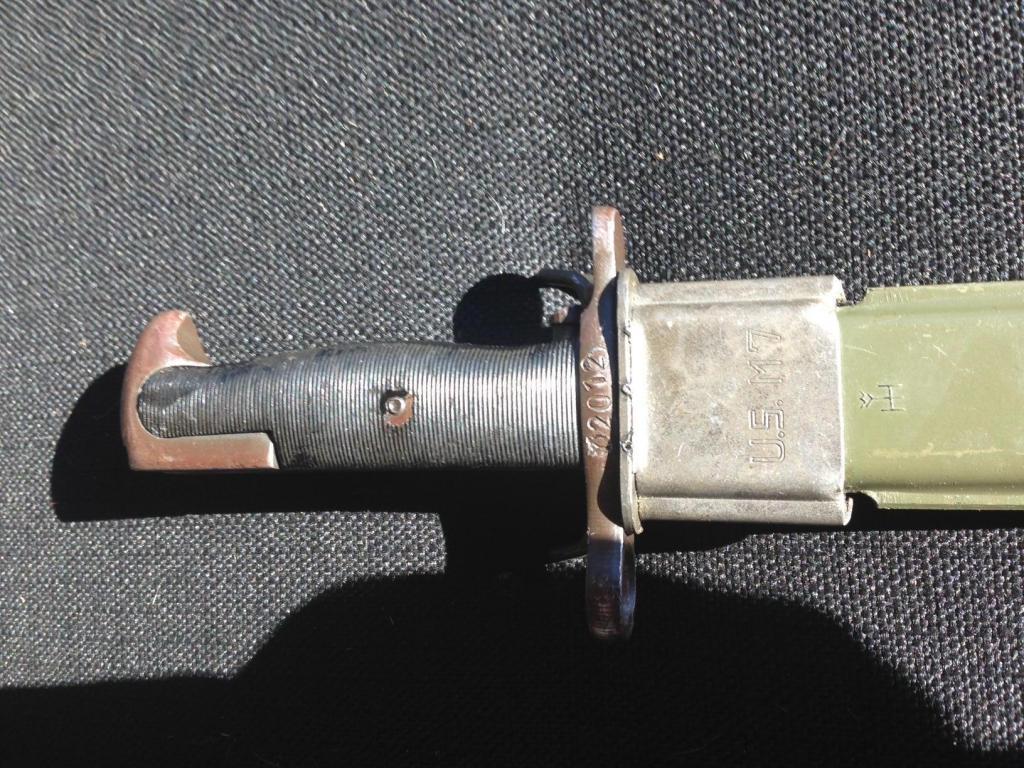-
Legacy Member

I thought the letter denoted the type of steel used. Open to correction on that, though.
Stocks and handguards had drawing #'s, so I'm pretty sure it's not a steel type. Here's what I found -
In Canfield's Collector Guide to the M1 Garand and M1 Carbine, he states SA devised the system. Each letter (A-F) designated a "drawing size".
Garand and M1 Carbine, he states SA devised the system. Each letter (A-F) designated a "drawing size".
In Poyer and Rieschs' book on the M1, it says "Four sizes of drawing sheets were used, designated by the letters A (8.5 X 11 inches), B (11 X 17 inches), C (17 X 22 inches), and D (22 X 34 inches). Maybe those were the four used solely on the M1?
Didn't see anything in any of my '03 books that I browsed through, so, open for correction here, too!
Mike
-
-
07-13-2013 11:33 AM
# ADS
Friends and Sponsors

-
Legacy Member

Photos of the bayonet -


-
-
Legacy Member

The bayonet is a Greek return as sold through the CMP .
.
-
-
Legacy Member

Usually blued, (actually a blue/black) I believe.
Thanks Rick,
Does usually mean always? The bolt has an x on top and a 2 underneath. What else s hold I look for to confirm authenticity of a smith corona bolt?
Thanks
Craig
-
-
Legacy Member

Craig, check out the web page http://www.vishooter.net. It has a lot of information on 1903's from all manufacturers.
From the information on that page, it looks like your Smith-Corona was made in Oct. of 1943
Month end serial numbers were:
Sep 4765852
Oct 4789047
The barrel date of 9-43 looks correct. Other reported serial number and barrel dates from the web site were:
4770985 SC 8-43
4774689 SC 9-43
4775xxx SC 9-43
478xxxx SC 9-43
47850xx SC 9-43
4785691 SC 8-43
4785888 SC 9-43
I also have a Smith-Corona 1903, but from Feb, 1943 -- markings are very similar to yours - boxed FJA and crossed cannons; square with 8 in it, diamond with 3, triangle - number not readable, circle with 8 in front of the trigger guard. Buttplate on mine is very similar to yours, and both are very similar to the photo of a S-C butt plate on the ViShooter web page, so they appear to be correct. I'm still researching mine, but have had it out to the range a couple of times and have found it to be very accurate.
Hope this helps.
Jim
-
-
Legacy Member

Thanks Jim,
Is your bolt blued or parkerised?
Craig
-
-
Legacy Member


Originally Posted by
Craig Eberhardt

Thanks Jim,
Is your bolt blued or parkerised?
Craig
Further to my last I had a good look at my bolt in the sun today. It appears that while the bolt is blued(although the blue is worn) the extractor is parkerised. I can just make out a feint letter which I think is R on the face adjacent to the bolt. It does not have an R on the ring that goes around the bolt. The letter R that I can see is in a different font to the R markings on the other bolt.
Would I be right in thinking I have a Remington extractor on my rifle? Suggestions as to where I might be able to source a Smith Corona extractor? As far as I can tell this is the only non Smith Corona part on my rifle so I am keen to fix it up if possible.
Regards,
Craig
-
-
Legacy Member

Craig - the bolt on mine is definitely blued -- almost black really. Does show wear from use - down to white metal in a few strips or areas. Also, it is marked with a 2 and a punch mark "underneath" -- on the flat, where the bolt handle joins the body of the bolt, but I didn't see any other markings on the bolt. Floor plate & trigger guard are stamped metal and were parkerized. Just noticed the front sight blade on mine is marked with an "A". The "A" is in a font with serifs. Also, I think it is just a minor variation, but the boxed FJA and crossed cannons on mine are set farther back than on your rifle -- on my rifle, they start just behind the trigger guard.
Hope this helps.
Jim
Jim
---------- Post added at 12:37 AM ---------- Previous post was at 12:30 AM ----------
By the way, the drawing sizes A, B, C, and D you referenced are standard engineering drawing sizes. Back when engineering drawings were produced by hand with pen/pencil on a drafting table (not on a computer like they are today) the "D" size was the standard "full-size" drawing. "B" size (11 x 17) were typically reduced size prints that were much easier to work with in the field. There is also a larger "E" size drawing that was much less common than the ones you listed -- don't remember the size, but it was larger than 22 x 32 -- this was most often used for plot plans.
Jim
-
-
Legacy Member


Originally Posted by
jbrid

Craig - the bolt on mine is definitely blued -- almost black really. Does show wear from use - down to white metal in a few strips or areas. Also, it is marked with a 2 and a punch mark "underneath" -- on the flat, where the bolt handle joins the body of the bolt, but I didn't see any other markings on the bolt. Floor plate & trigger guard are stamped metal and were parkerized. Just noticed the front sight blade on mine is marked with an "A". The "A" is in a font with serifs. Also, I think it is just a minor variation, but the boxed FJA and crossed cannons on mine are set farther back than on your rifle -- on my rifle, they start just behind the trigger guard.
Hope this helps.
Jim
Hi Jim
Jim
---------- Post added at 12:37 AM ---------- Previous post was at 12:30 AM ----------
By the way, the drawing sizes A, B, C, and D you referenced are standard engineering drawing sizes. Back when engineering drawings were produced by hand with pen/pencil on a drafting table (not on a computer like they are today) the "D" size was the standard "full-size" drawing. "B" size (11 x 17) were typically reduced size prints that were much easier to work with in the field. There is also a larger "E" size drawing that was much less common than the ones you listed -- don't remember the size, but it was larger than 22 x 32 -- this was most often used for plot plans.
Jim
Hi Jim,
Mine is also marked with an x and a 2 and punch mark underneath. Looks like it is the real deal bar the extractor.
Craig
-
-
Legacy Member

Craig you have a really nice rifle. I also have a SC from 1943. I never really worried to much about every little part in it being SC because the only time they were ever (original) was when they were first issued or sent straight to storage. The first GI party would have taken care of that. When you have a half dozen guys or more throwing all the parts in the same bucket of solvent to remove the cosmoline The chances of getting all the the same parts back into your rifle were-----well don't take those odds to Vegas. All US military rifles were built to plug and play parts to each model. Any 03 Springfield parts should fit a Remington or Smith. As in the M1
The chances of getting all the the same parts back into your rifle were-----well don't take those odds to Vegas. All US military rifles were built to plug and play parts to each model. Any 03 Springfield parts should fit a Remington or Smith. As in the M1 any Springfield parts should replace anything in a Winchester, IHC or HR.
any Springfield parts should replace anything in a Winchester, IHC or HR.
After the fighting was done discarded or broken weapons were gathered and armorers in the field would take the parts from non repairable weapons and use them to fix those that were repairable and then they would be reissued. After all hostilities were finally over they would be shipped to an arsenal and gone over again before reissue or storage. So when I see the question poised is this the correct part I always reply does it fit? Does it function correctly. Does the gun go bang? Then it's the right part. By the way mine does have a Remington bolt.
-
Garand and M1 Carbine, he states SA devised the system. Each letter (A-F) designated a "drawing size".















 PM
PM









